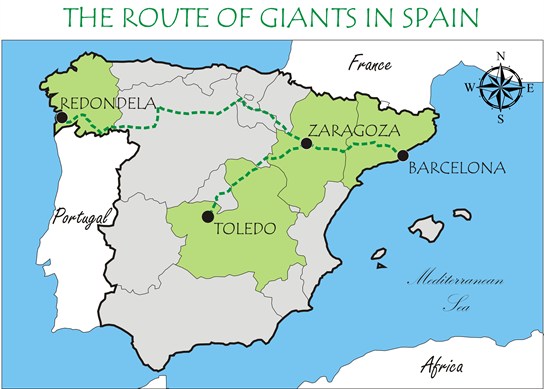The Giants in Spain
 In Spain, the origin of processional giants seems to date back to the fourteenth century. Their existence however, is attested with greater certainty only from the following century onwards. The first examples of the various giants in Spain (in anthropomorphic and zoomorphic forms) parade during the processions of Corpus Christi and are to be placed in a broader framework of mystery plays inspired by the Bible, called entremeses. In addition to the giants (gigantes in Castilian, in Catalan gegants), there are also dwarfs (called cabezudos or capgrossos), the cavalls Cotoners (little cloth horses worn by men which hearken back to the figure of the centaur, a hybrid widespread in France under the name of chevaux-jupon, which usually accompany the giants and monstrous beasts) and a long list of animal figures: the Drac, the Aliga, the Vibria, the Tarasca, the Mulassa, the Ox, the Lion. The Spanish giants, like their European counterparts, walked on stilts at the beginning and were dressed in cloth and then took more rigid forms and more stable postures.
In Spain, the origin of processional giants seems to date back to the fourteenth century. Their existence however, is attested with greater certainty only from the following century onwards. The first examples of the various giants in Spain (in anthropomorphic and zoomorphic forms) parade during the processions of Corpus Christi and are to be placed in a broader framework of mystery plays inspired by the Bible, called entremeses. In addition to the giants (gigantes in Castilian, in Catalan gegants), there are also dwarfs (called cabezudos or capgrossos), the cavalls Cotoners (little cloth horses worn by men which hearken back to the figure of the centaur, a hybrid widespread in France under the name of chevaux-jupon, which usually accompany the giants and monstrous beasts) and a long list of animal figures: the Drac, the Aliga, the Vibria, the Tarasca, the Mulassa, the Ox, the Lion. The Spanish giants, like their European counterparts, walked on stilts at the beginning and were dressed in cloth and then took more rigid forms and more stable postures.
Between the end of the fourteenth century (1380) and the beginning of the fifteenth (1424), the giant Goliath (with David) and the superhuman puppet of Saint Christopher (with the baby Jesus on his shoulders) made their appearance in the Corpus Christi of Barcelona. It seems that in Valencia, in 1399, on the occasion of the coronation of Martin IMartin I of Aragon, known as the Humane (l’Humà ) or the Ecclesiastic (1356-1410) was the last descendant of the House of Barcelona and the last of the heirs of Wilfred the hairy and the subsequent “Counts-Kings” to reign over Aragon. In addition to the throne of Aragon, he was also ruler of Valencia, Sicily (as Martin II), Sardinia, Corsica and Majorca, Count of Barcelona, Roussillon, Cerdanya and Empuries, first Duke of Montblanc., viewers witnessed the symbolic killing of a dragon. In the Corpus Christi of Toledo of 1372 the presence of the eagle is attested to, while from 1493 the four continental giants are present along with the Tarasca, on whose back a puppet of Anne Boleyn was placed. During the Early Modern period giants and figures that accompanied them underwent progressive change. In Granada, in 1767, alongside the Tarasca there were seven giant Roman emperors, guilty of having opposed Christianity (similarly, in Seville there were six emperors and the Tarasca which personified the 7 deadly sins). The dwarfs, however, were already present in the sixteenth century in Valencia: some symbolize, paired with the giants, the subjugation of the small and the great to God; for others, they might even be the progenitors of colossuses. Giants, animal figures and dwarfs have all survived to the contemporary age and to the present day.
